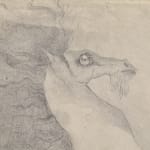




Leonora Carrington British-Mexican, 1917-2011
Further images
Growing up, Leonora Carrington had a rebellious streak. She was expelled from two schools and refused to conform to the debutante lifestyle imposed by her family. After forming an instantaneous connection with Max Ernst at a dinner party in 1937, she defied her parents again by running away to join him in France. At this time, Leonora was only beginning her journey as an artist, in contrast to Ernst, who was twenty-six years her senior and already a major figure in the Surrealist movement. The years they spent cohabitating between 1938 and 1939 would prove hugely influential to the trajectories of both their careers. In May 1940, Ernst was arrested by the Gestapo for producing “degenerate art”. Carrington fled to Spain in an effort to obtain a passport for her imprisoned lover. Their forced separation took a heavy toll on her, and her mental decline culminated in her parents forcibly institutionalizing her in the northern port city of Santander later that year.
Carrington drew The Horse in September 1940 during this dark period. The images she produced were partly influenced by the convulsive shock treatment she endured while institutionalized. Her recurring white horse was not only symbolic of Carrington herself but also served as a dialogic motif that she and Ernst shared in their work. By linking nature to an unconscious power or alter ego, The Horse does not rely on the eroticized female body to express identity, as many of Carrington’s male Surrealist contemporaries often did.
Max Ernst was released soon after Carrington’s internment and exiled to America. During his journey to the U.S. he fell in love with American art patron Peggy Guggenheim, and the two would marry shortly after. Carrington traveled to New York in 1941, where she met Surrealist art dealer Julien Levy. The honest affection of Carrington’s friendship with Levy is transcribed by the inscription, “J. I love you” written on the verso as she sold this artwork to him. The two would remain close until Levy’s death in 1981.




